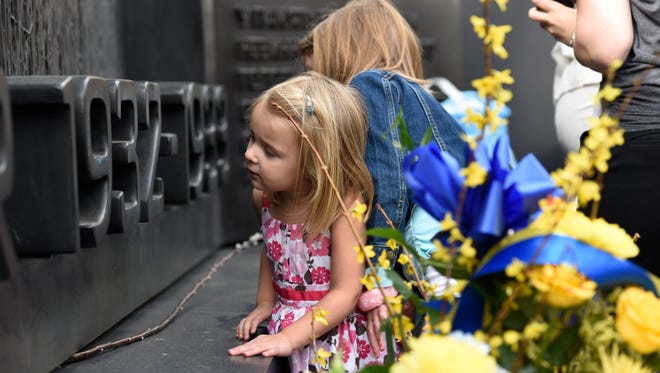Ukraine marks Holodomor Remembrance Day 90 years after Soviet famine
As the Ukrainian government worked to restore power and water following recent Russian military strikes, Ukrainians were mourning a Moscow-backed atrocity that began 90 years ago: the Holodomor.
The Holodomor, which translates roughly to “death by hunger” in Ukrainian, is also known as the Great Famine. More than 3 million people died over two years as the Soviet government under Josef Stalin confiscated food and grain supplies and deported many Ukrainians.
Pope Francis linked the current suffering of Ukrainians to the 1930s man-made famine, describing it Wednesday as “genocide artificially caused by Stalin.”
He noted that Saturday marks the 90th anniversary of the start of the famine, which Ukraine commemorates every fourth Saturday of November with a Day of Memory. “Let us pray for the victims of this genocide and let us pray for so many Ukrainians – children, women, elderly, babies – who today are suffering the martyrdom of aggression,” Francis said.
Ninety years after the atrocity, Russia has “unleashed a full-scale war against us and wants to organize Holodomor 2.0,” Andriy Yermak, the head of Ukraine’s presidential office, said Saturday on Twitter.
“The crime must be punished,” he said. “The world must hold the aggressor accountable.”
Ukraine update:100,000 Russians killed or wounded in war; US won’t push Ukraine into peace talks
Infrastructure targeted in attacks:Russian missiles, snow stagger Ukraine

What is the Holodomor and what caused it?
The Holodomor translates roughly to “death by hunger” in Ukrainian. It is how Ukrainians refer to the mass starvation deaths of millions in Ukraine from 1932 to 1933 under Soviet dictator Josef Stalin. The Holodomor was part of a larger famine that swept the Soviet Union as Stalin collectivized the agricultural economy by taking over small farms and prohibiting independent farmers from selling their crops. But specific policy decisions targeting Ukraine intensified the famine there, leading Ukraine and many nations to recognize the Holodomor as a genocide. It’s held that Stalin allowed Ukrainians to starve in order to quash Ukrainian resistance to the reorganization of its farms.
When did the Holodomor start?
The Holodomor took place from the early 1930s.
Did Stalin deny the Holodomor?
Stalin and the Soviet Union never recognized the Holodomor as a genocide. Discussion of the event was heavily repressed inside the Soviet Union and the USSR undertook a campaign to conceal the atrocity from the rest of the world.
As Anne Applebaum reported in the Atlantic, journalists in the Soviet Union were subject to intense censure from Moscow. Western reporters, including New York Times reporter Walter Duranty, a Pulitzer-prize winner, downplayed the situation in Ukraine. “Conditions are bad, but there is no famine,” he infamously wrote in one 1933 story.
The present-day Russian government minimizes what happened. In 2017, Russian Spokesperson Maria Zakharova told reporters that the characterization of the starvation as a genocide “contradicts historical facts.”
How many people died in the Holodomor?
Scholars have estimated that anywhere from 3 to 7 million people died.
When is Holodomor Remembrance Day?
Holodomor Remembrance day is observed on the final Saturday of November.
Does the United States recognize the Holodomor?
The United States opened in 2015 a memorial for the Holodomor on the National Mall in DC, and the Obama and Biden White Houses have issued remembrance statements on Holodomor Remembrance Day. But the United States has been stopped short of calling the Holodomor a genocide, even as several countries, including Canada, recognize it as such.
“As we remember the pain and the victims of the Holodomor,’ the statement read, “the United States also reaffirms our commitment to the people of Ukraine today and our unwavering support for the sovereignty and territorial integrity of Ukraine.”
The U.S. Senate and House of Representatives have passed resolutions recognizing the Holodomor as genocide, as have more than 20 U.S. states. The Holodomor Museum lists the U.S. among the 16 states in addition to Ukraine that have recognized the famine as genocide: Australia, Ecuador, Estonia, Canada, Colombia, Georgia, Hungary, Latvia, Lithuania, Mexico, Paraguay, Peru, Poland, Portugal, and the Vatican. Some other countries, such as Argentina, Chile and Spain, have condemned it as “an act of extermination.”
Images from the Russian invasion:‘Brutal act of war’: Photos of Russia invading Ukraine show mass evacuations, rockets
Ukrainian cities under attack:Ukraine-Russia crisis: How do you pronounce Donetsk? And is it Kyiv or Kiev?
Why is the Holodomor important?
Despite the death of millions resulting from deliberate policy decisions by Stalin’s regime, the Holodomor isn’t widely known in the United States. But it is a key part to understanding the deep divisions between Russia and Ukraine. It marks an early and brutal example in what many Ukrainians say is a long history of Moscow’s hostility toward its southwestern neighbor.
Russians and Ukrainians are now retracing much of the history that has long been at the core of the tension between the two former Soviet Republics.
One of Vladimir Putin’s central justifications for launching a war against Ukrainewas his claims that the two countries constitute one people.
Contributing: Mike Snider, The Associated Press
